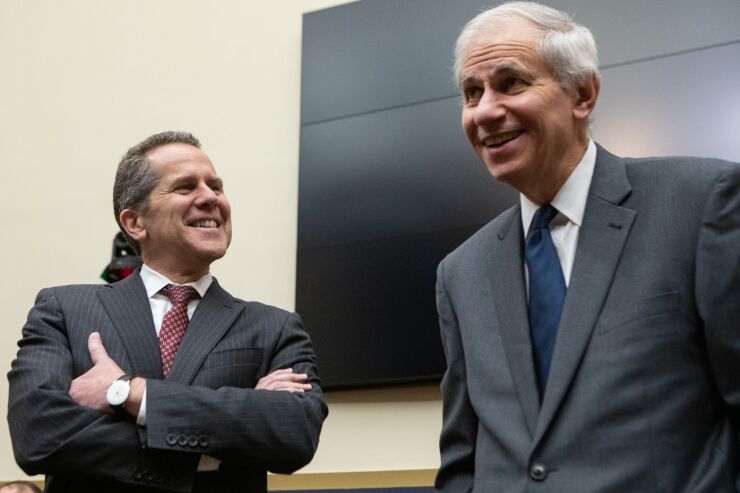Regulators say banks have been ‘fairly positive’ about the new CRA rule

Bloomberg News
Federal regulators say there are new opportunities for banks in their recently finalized rule overhauling the implementation of the Community Reinvestment Act.
Federal Deposit Insurance Corp. Chair Martin Gruenberg, Acting Comptroller of the Currency Michael Hsu and Federal Reserve Vice Chair for Supervision Michael Barr discussed the intricacies of the rule in a webinar hosted by the National Community Reinvestment Coalition on Friday afternoon.
During the event, the nation’s top bank cops noted that certain provisions of the revised CRA framework apply new levels of flexibility. This includes the ability to earn credit for non-traditional banking services — such as backing job training and workforce development initiatives — and the ability to get CRA credit for community development activities undertaken anywhere in the country.
They also pointed to new quantitative methods for assessing compliance with the rules and the establishment of a more open dialogue about what novel activities might be eligible for credit.
“One of the things this rule does is set out a set of illustrative practices that are going to be eligible for CRA consideration and also provides a process that can confirm somebody who’s unsure about whether something counts or doesn’t count,” Barr said. “They can come ask us and we’ll say ‘Yeah, that’s that’s good. That counts for CRA,’ and share that with others.”
Gruenberg said the flexibility in the new rule will accommodate all types of business models in banking, including novel ones that have yet to surface. He added that he believes banks have responded well to these elements of the reform.
“The general reaction we’ve received is quite positive. Certainly from the community organizations and civil rights groups, but I think initial feedback from the banking community, I think, has been fairly positive,” he said. “Although I want to give them some opportunity to work their way through it.”
In the wake of the rule’s finalization last week, banking trade groups issued a variety of statements. Some thanked the regulators for modernizing the implementation of the 46-year-old law, while others said they still needed to comb through the 1,500-page document to determine their support.
Some banks, meanwhile, raised pointed issues with the finalized rule. In particular, the threshold for being considered a “large bank” for CRA purposes being set at $2 billion of assets drew the ire of small banks and their allies. For most supervisory standards, banks with $10 billion of assets or less are considered community banks and are thus shielded from many obligations.
In a statement, the Independent Community Bankers of America, a trade group for small and mid-sized banks, said the package holds some beneficial changes for its members, but would overall saddle them with outsized compliance costs.
“By classifying all banks over $2 billion in assets as large banks, we are very concerned that the rule does not sufficiently differentiate between community banks and the nation’s largest banks,” ICBA President and CEO Rebeca Romero Rainey said in the statement.
The final rule also drew objections from Fed Gov. Michelle Bowman, the designated community banking member on the Board of Governors, as well as FDIC Directors Jonathan McKernan and Travis Hill. In their dissenting statements, the officials noted that the rule could exceed the statutory limitations of the CRA.
Enacted in 1977, the CRA requires banks to extend credit, investments and services to all communities within its service area, a mandate that has traditionally been tied to physical branch locations. One of the key goals of the reform effort — which has gone through fits and starts over the past several years — was to factor the increasing online nature of banking into the framework.
But, McKernan said it was not clear to him that the law allows for such an expansion.
“I have not seen a convincing argument that we have the authority to consider lending activities outside a bank’s facility-based assessment areas,” he said before voting against the rule.
Legal and policy analysts say banks could have grounds for mounting a legal challenge against the finalized rule, though it remains unclear how much appetite there is for such an approach among the banking community.
Hsu acknowledged some of the criticisms that have…
Read More: Regulators say banks have been ‘fairly positive’ about the new CRA rule

